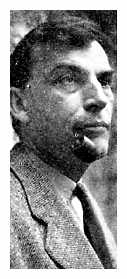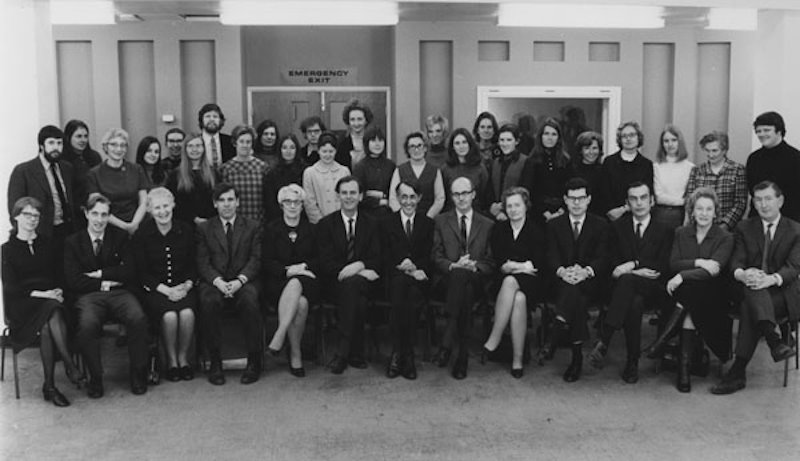Known for his part in establishing the English Stage Company, the American sociologist George W. Goetschius also made a key contribution to deepening the thinking and practice of community development and detached youth work. We explore his work and life.
contents: introduction · life · working with unattached youth · working with community groups · conclusion · further reading and references · how to cite this article

Life
George Goetschius was born in Little Neck, Long Island on March 17 1923. He studied sociology at New York University and this was followed by an MA at Columbia in 1947. Harriet Devine (2006b) reports that following on from his studies he worked as a settlement worker in Manhattan’s Lower East Side (at the Hamilton and Madison House settlements). At that time the area was going through considerable changes. It had become populated primarily by African-Americans and Hispanics and there was considerable tension between them and the ‘pre-war community’. Teenage gangs were beginning to be experienced as a real problem (Hamilton-Madison House 2006). Conscripted into the US army at the time of the Korean War he was later invalided out. He then gained a fellowship to work with the radical Sicilian social activist Danilo Dolci (1924-1997). Dolci was working with local farmers and collectives to win water rights and work away from the Mafia. A champion of nonviolent action, one of his innovations was the strike in reverse’ – the development of unauthorized public works projects for the poor (McNeish 1965; Dolci 1981). Goetschius was also involved in the organization of the Berlin international conference on settlement work at this time (Kuenstler 2007).

The English Stage Company and the playwrights and directors associated with it was a key force in reshaping British theatre. The description of John Osborne as an ‘angry young man’ in a press release linked to the first production of Look Back in Anger came to be used as a way of describing this movement. But, as George Goetschius recognized, there was a very strong class dimension to this
The success of the (Royal) Court I would attribute to its allowing itself after Look Back in Anger to become one of the rallying points for those elements in the middle-class who were attempting to clear the social scene of what they saw to be some of its impediments and irrelevancies. In this sense the Court was a theatre of middle-class transition. (Goetschius 1966: 33)
The work that the Company developed and pioneered helped to challenge long-standing attitudes and positions including the anachronistic censure laws that existed in England and Wales at the time. Tony Richardson also went on to direct a series of iconic British films including Look Back In Anger (1958), The Entertainer (1960, A Taste of Honey (1961) and The Loneliness of the Long Distance Runner (1962).
Harriet Devine (2006b) reports that in early 1958, George Goetschius went to work with the Delhi development authority on the new master plan for the Indian capital commissioned by the prime minister, Jawaharlal Nehru (he was sent by the Ford Foundation). While working there he contracted a severe form of hepatitis which forced him to return to England. He recovered, but the illness appears to have contributed to the breakdown of his health in later years. George Goetschius’ relationship with Tony Richardson ended in 1959 when Richardson went to live with the actor Vanessa Redgrave. Goetschius stayed in the flat and was joined there a few months later by the playwright Donald Howarth (Devine 2006b).
In 1960, George Goetschius joined the staff at the London School of Economics. It was during this period that he undertook the research with M. Joan Tash for Working with the Unattached, and brought together and developed material for Working with Community Groups. Working with the Unattached has achieved the status of a youth work ‘classic’ (see Pugh 2001). It remains one of the few sustained explorations of ‘detached youth work’ and has not been matched for the rigour and depth of its treatment. Working with Community Groups appeared at a propitious moment and was an important addition to the literature. There had been a significant rise of interest in community work – but there was also beginning to be an important shift in emphasis with apparently more ‘radical’ voices and practice coming to the fore (see the discussion in our review of community work). The careful, neighbourhood approach advocated by George Goetschius was dismissed by some of this new wave – often rather to the cost of the resulting practice.

George Goetschius’s LSE course on community development and community action was ended in 1973. Harriet Devine (2006b) has reported that depressed by this and by difficulties in his relationship with Howarth, ‘he suffered a mental and physical breakdown from which he never fully recovered’. He was virtually bedridden for many years and spent most of the 1980s at Donald Howarth’s cottage in mid-Wales (Tyn y Pant). His health did improve and he returned to London. In 2004 he went into a nursing home on Richmond Hill and in February 2006 his almost 50-year relationship with Howarth was legalised in a civil partnership (op. cit.). George Goetschius died on October 11, 2006, and was buried in the garden of Tyn y Pant.
Working with unattached youth
Working with Unattached Youth: Problem, approach, method (Goetschius and Tash 1967) remains one of the most sustained pieces of research into youth work in the UK. Published as part of the famous blue-covered International Library of Sociology and Social Reconstruction, it remains an important landmark and point of reference. The book’s subtitle spells out the focus: ‘The report of an enquiry into the ways and means of contacting and working with unattached young people in an inner London Borough’. The report examines the work and experiences of the five field workers employed on the project and some of the participating young people. The Project, founded and managed by the London YWCA, and funded by the Carnegie United Kingdom Trust and Department of Education and Science (DES), began by working from a coffee stall. Based around Marylebone and the Edgware Road (the site of an earlier influential project run by Marie Paneth) it developed into a fascinating piece of work. George Goetschius was the consultant to the project (seconded thanks in significant part to a grant from the Gulbenkian Foundation). M. Joan Tash was the project administrator, but like George Goetschius had significant experience in settlement work and development work. [There is more on the Project in the article on Joan Tash]
One of the defining features of the book is the brilliant use the writers make of case study materials. Much of this material remains illuminating and is still referred to by some training programmes. The material derived from participant observation, extracts from recordings by the workers, notes from meetings etc. The value of the material is much enhanced by the insightful commentaries offered by Goetschius and Tash. In addition, they focus on some key notions or ideas that they see underpinning the practice, a number of which had not had proper attention in the literature. Central to this was their exploration of the notion of relationship.
George Goetschius and M. Joan Tash’s exploration of approach and method echoed earlier North American models of social work, but they gave it a significant twist by the strength of their focus on the self and social education. They looked to:
- Work with individuals,
- Work with groups,
- Work with the community,
- Work with ourselves, and
- Social education (1967: 135-285)
One of the great virtues of the approach that they took was that it brought out the significance of the process of cultivating extended reflection on the part of the workers.
Working with community groups
Working with community groups (1969) was also published in the International Library of Sociology and Social Reconstruction. Based on an exploration of the work of the London Council of Social Service with housing estate groups it both provides a fascinating insight into a particular area of social policy over a period of 15 years or more and into the forms that community development practice could take at the local level. It wasn’t until the late 1950s and early 1960s that accounts of practice and theoretical explorations began to appear in the UK that viewed community workers as a distinct occupation. Prior to this, there were separate groups of workers such as community centre wardens, secretaries of councils of social services and development workers on new housing estates. As David N. Thomas (1983: 25) has argued, the main orientation was to the educational. This was to be expected in many respects, given the process-focus of many of the key figures, and the institutional location of much of the funding and work. The Younghusband Report (1959) on social work was a significant turning point. It specifically drew on the North American division of social work into casework, group work and community organization, but it was the terms ‘community development’ and ‘community work’ that became popular – and tended to merge. The term ‘community development’ was adopted by many U.K. workers and projects for work that focused on work with local neighbourhood groups to set and meet their own needs. The changes were symbolized in two initiatives – the setting up a study group by the Gulbenkian Foundation in 1966 (the first report appeared in 1968) to look at the nature and future of community work in the UK; and the development of the Community Development Projects by the Home Office as part of an anti-poverty strategy (see Loney 1983).
George Goetschius’ contribution was to draw upon a wealth of material from one of the forerunner strands (estate work) and to weave it into a series of reflections and insights into work with local groups. Like some other contemporary commentators (e.g. the Battens), and Goetschius’ previous work with Joan Tash, there was a strong focus on process, learning and the different aspects of ‘working with’. However, as Martin Loney (1983: 23) has commented, the community workers who entered the field in the late 1960s and early 1970s frequently rejected what they saw as ‘traditional’ (educational) models of community work. They replaced the process-oriented approaches of Goetschius and Batten and Batten (1967) with a commitment to organizing and a readiness to take up oppositional positions (Baldock 1977). Today we can see what was lost by the failure to take on the insights of writers such as George Goetschius.
First, Goetschius’ emphasis upon autonomous, local community groups makes a great deal of sense in terms of current debates around civil society and social capital. He argued that they should be seen as ‘a natural, useful and necessary buffer or intermediary between the individual and the larger, more formal groups and institutions of society’ (1969: 184). Second, George Goetschius has some pertinent things to say about the placing of community development work He argues that it is ‘possible to describe the method as a form of social education’. In some respects, his focus here has some overlaps with the German tradition of social pedagogy and the Scottish tradition of community education. There are also some echoes of the informal education tradition.
The role of the worker, and the agency, is that of an outside resource person who helps to create a situation in which learning can take place, and who can pass on skills and help them to take effect in the life and work of those who are learning to use them. This kind of social education can take place in any circumstances, at any time….
In all the examples the common factor is the attempt to help individuals, groups and social institutions understand, accept or reject, use and affect, their social environment. (Goetschius 1969: 184-5)
Like Working with unattached youth, this book also brims with case material that is designed to help with teaching about and exploring the work. Unlike some of the material that appeared at the time, Working with community groups was fully grounded in practice.
Conclusion
It is a matter of great sadness that George Goetschius wasn’t able to continue with his detailed exploration of practice. With things shifting away from his principal concerns in much of English community work at the time, his voice was needed. Within youth work, his currency remained strong well into the 1980s – and he would have found many willing listeners. His work with Joan Tash still retains a significant degree of freshness – all the more for being out of step with the dull hegemony of current governmental concerns in England at least.
Only two years separated his two seminal books – but they drew upon years of experience and careful exploration. Three particular elements should command our attention today.
First, practitioners still need an ethnographic and sociological imagination and to take on many of the ways of social anthropologists.
Second, the disciplines that both Goetschius and Tash explored – supervision, group exploration, recording – and the reflection on self and situation entailed, allow for the possibility of significant workaround process.
Lastly, there is much to be gained at a local level in re-exploring the other processes Goetschius examined. His and Joan Tash’s attention to relationship, their framing of work with young people and others within a concern for community, and their attention to engaging with group life as it existed offer a refreshing contrast.
Further reading and references
Baldock, Peter (1977). ‘Why community action? The historical origins of the radical trend in British community work’, Community Development Journal 12(2) also reprinted in P. Henderson and D. N. Thomas (eds.) (1981) Readings in Community Work, London: George Allen and Unwin.
Batten, T. R. and Batten M. (1967). The Non-Directive Approach in Group and Community Work. London: Oxford University Press.
Calouste Gulbenkian Foundation (1968). Community Work and Social Change. A report on training, London: Longman.
Devine, Harriet (2006a). Being George Devine’s Daughter. London: Barkus Books.
Devine, Harriet (2006b). ‘Obituary: George Goetschius’, The Guardian, November 6, 2006. http://www.guardian.co.uk/obituaries/story/0,,1940354,00.html. Accessed November 6, 2006.
Dolchi, Danilo (1981). Sicilian Lives. Pantheon Books.
Goetchius, George (1955). The National Health Service in Great Britain: Some consumer reactions [Supervised by Professor Richard Titmuss of the London School of Economics, approved by Doctor Mallon, Toynbee Hall, on behalf of the National Federation of Settlements and Neighbourhood Centre, 226 West 47th St., New York City]. Held by the London School of Economics
Goetchius, George (1966). ‘The Royal Court in its social context’, in The English Stage Company Ten Years at the Royal Court 1956-1966. London: English Stage Company.
Goetchius, George and Tash M. Joan (1967). Working with Unattached Youth: Problem, approach, method. London: Routledge and Kegan Paul.
Goetchius, George (1969). Working with Community Groups. Using community development as a method of social work. London: Routledge and Kegan Paul
Goetschius, George (1970). ‘Some observations on the role of the consultant in an experimental youth work project’ in Derek Cox A Community approach to youth work in East London : a report – ‘Avenues unlimited’ (The Tower Hamlets youth project). London: YWCA.
Hamilton-Madison House (2006). The Hamilton-Madison House Story 1898 – 2006. New York: Hamilton-Madison House, http://www.hmhonline.org/. Accessed November 8, 2006.
Kuenstler, Peter H. K. (2007). Personal correspondence with the writer (February 5, 2007).
Loney, M. (1983). Community Against Government. The British Community Development Project 1968-78: a study of government incompetence. Heinemann.
Pugh, Caroline (2001). ‘Youth work classics revisited: Working with unattached youth’, Youth and Policy 65.
McNeish, James (1965). Fire Under the Ashes. The life of Danilo Dolci. London: Hodder and Stoughton.
Smith, H. and Smith, M. K. (2007). The Art of Helping Others, London.
Thomas, David N. (1983) The Making of Community Work. London: George Allen and Unwin.
Younghusband, Eileen. L. (1959). Report of the Working Party on Social Workers in the Local Authority Health and Welfare Services. London: HMSO.
Acknowledgments: The photograph of the Royal Court Theatre – the home of the English Stage Company – is by Dasha Stokoz | flickr ccby2. Royal Court Theatre – the home of the English Stage Company – Dasha Stokoz | flickr ccby2. The photograph of the LSE team is from the Library of the London School of Economics and Political Science, No restrictions, via Wikimedia Commons. The image of the ‘Look Back in Anger’ poster is from Wikipedia: By Source (WP:NFCC#4), Fair use, https://en.wikipedia.org/w/index.php?curid=55925744
How to cite this article: Smith, Mark K. (2006, 2020). ‘George Goetschius, community development and detached youth work’ in The encyclopedia of pedagogy and informal education. [https://infed.org/mobi/george-goetschius-community-development-and-detached-youth-work/. Retrieved: insert date]
© 2006, 2020 Mark K. Smith
